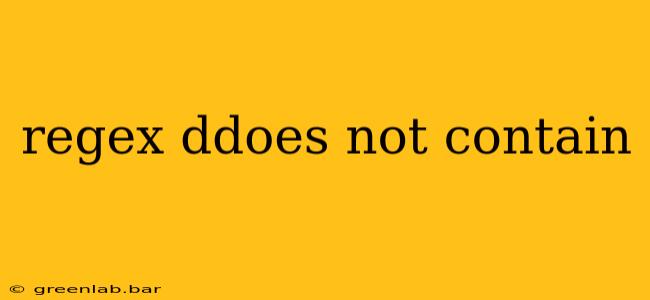Mastering the Art of Negative Regex: Ensuring Strings Don't Contain Specific Patterns
Regular expressions (regex or regexp) are powerful tools for pattern matching within strings. While often used to find specific patterns, they're equally capable of identifying strings that lack certain patterns. This is where negative regex comes into play, allowing you to efficiently filter out unwanted data or validate input based on the absence of certain elements. This guide will explore the techniques and applications of negative regex, focusing on how to ensure a string does not contain a particular pattern.
Understanding Negative Lookarounds
The core of negative regex lies in lookarounds. These are zero-width assertions; they don't consume characters in the string but simply check for the presence or absence of a pattern without including it in the match. There are four types:
- Positive Lookahead (?=...): Asserts that the following characters match the pattern.
- Negative Lookahead (?!...): Asserts that the following characters do not match the pattern.
- Positive Lookbehind (?<=...): Asserts that the preceding characters match the pattern. (Support varies across regex engines.)
- Negative Lookbehind (?<!...): Asserts that the preceding characters do not match the pattern. (Support varies across regex engines.)
For ensuring a string does not contain a specific pattern, the negative lookahead (?!...) is most commonly used.
Practical Examples: Negative Lookahead in Action
Let's illustrate with some practical scenarios:
1. Validating Email Addresses (Without a Specific Domain):
Imagine you need to ensure an email address doesn't belong to a particular domain, say, example.com. We can use a negative lookahead:
^[^@]+@[^@]+\.(?!example\.com)[^@]+$
^[^@]+@: Matches one or more non-@ characters followed by an "@" symbol.[^@]+\.: Matches one or more non-@ characters followed by a ".".(?!example\.com): This is the negative lookahead. It asserts that the following characters do not match "example.com".[^@]+$: Matches one or more non-@ characters until the end of the string.
This regex will only match email addresses that do not end with example.com.
2. Finding Strings Without a Specific Word:
Let's say you want to find all lines in a text file that do not contain the word "error". You could use:
^(?!.*error).*$
^: Matches the beginning of the line.(?!.*error): Negative lookahead. Asserts that the line does not contain "error" anywhere..*: Matches any character (except newline) zero or more times.$: Matches the end of the line.
This regex will only match lines that lack the word "error".
3. Filtering Out Numbers in a String:
To find strings that contain only alphabets and do not contain any numbers, you would use a regex like this:
^[^0-9]+$
This regex matches strings that do not contain any digits (0-9) from beginning to end. This effectively filters out strings containing any numbers.
Important Considerations:
- Regex Engine Support: The support for lookbehind assertions can vary across different regex engines (e.g., PCRE, Python's
re, JavaScript's built-in regex). Negative lookaheads are generally more widely supported. - Complexity: While powerful, complex negative regex patterns can be difficult to read and maintain. Consider simpler alternatives if possible.
- Testing: Always thoroughly test your negative regex patterns with a variety of input strings to ensure they behave as expected.
By mastering negative lookarounds and other negative regex techniques, you can significantly enhance your pattern-matching capabilities, effectively filtering and validating data based on the absence of specific patterns. This opens doors to more robust and precise data processing in various applications.

